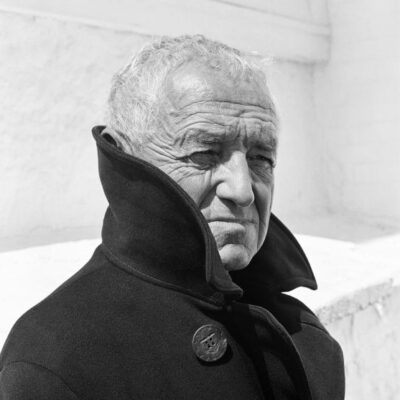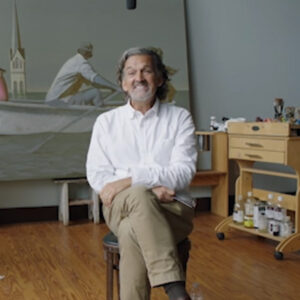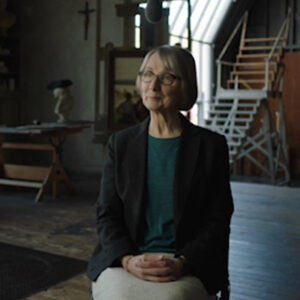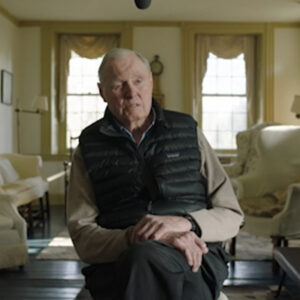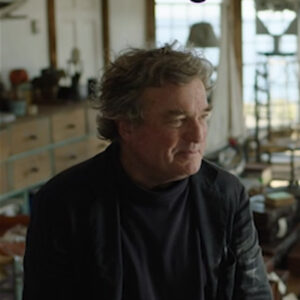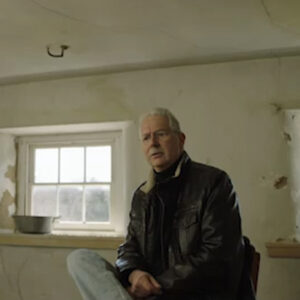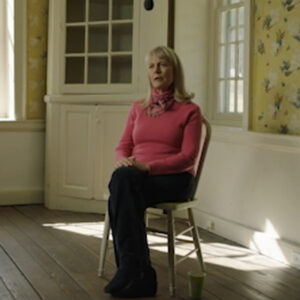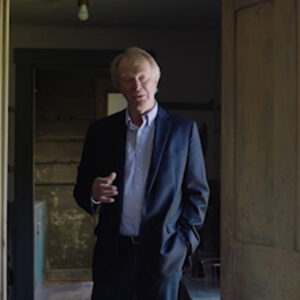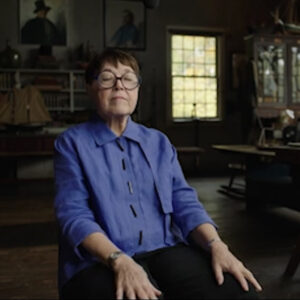Speaker I am Audrey Lewis, I am curator at the Brandywine River Museum of Art, how? I’ve been working. I have locked away. I always do that. I’m sorry I worked here since nineteen. Oh, sorry, 2007, 10 years now.
Speaker And tell me about the relationship. And this is again, just. Yeah.
Speaker Tell me about your relationship with the work of your wife when that person’s sex is your life and when we first love it.
Speaker Well, I grew up in the area, so I knew his work. My parents had the roasted chestnuts poster in their bedroom. And so I knew Christine as world, of course. But I really didn’t pay attention to his work until I entered art history in graduate school. That wasn’t even because of graduate school, because they didn’t teach Andrew why they graduate school. But it just I was visiting local museums more and came to the Brandywine. And believe it or not, I don’t think I’d been there previously if I had. It was probably to see the trains or some something like that. So that was my first introduction. And then when I was at the Philadelphia Museum of Art, the memory magic show was was being planned and organized. And I was on the periphery of that. I wasn’t involved in the organization or the curating of that exhibition. That was Kathy Foster, as you know.
Speaker So what’s an interesting thing? Why don’t you do what was taught in our history?
Speaker Just I’m sorry. It’s art. That’s what we’re all here.
Speaker OK, so I think it’s partly because, well, it’s totally because he’s not part of the modernist canon of American artists and nobody knows what to do with him when they do teach him. So when I was teaching Serguei, he would just be introduced for one painting and then it would go back to abstract expressionism or pop art. He didn’t he didn’t linger long because he just wasn’t part of the avant garde. And that was what was majorly taught, at least when I was in graduate school. I think it’s more expansive now because they’re more sensitive to leaving out certain groups and gender sexuality and and he doesn’t fit in those groups.
Speaker So he really has a problem.
Speaker But there’s more attention to him now, especially in the last 15 years on the from the standpoint of historians of art. And critics have taken a new look at him as well.
Speaker I was going to talk about that, that sort of new wave of attention. What do you think is happening? And you said it in a little bit, sort of sitting in his car. Mm hmm.
Speaker Well, in 2007, the Philadelphia Museum of Art let me start over, because I think it was 2006 actually started earlier in 1998, the Whitney Museum of American Art did a retrospective of his watercolors and just looked at his watercolors. Nobody had ever just focused on them before. And that really introduced people to his wide ranging stylistic innovations. When he was a young man, he painted in a certain way. He painted in the style of Winslow Homer just at the beginning of his career, and then he transformed into finding his own way.
Speaker Then after that, the night like. Now see this. I’m sorry. I’m sorry to back up. 2006, Philadelphia Museum of Art created the Memory and Magic exhibition. That was a retrospective that was focused on themes. It wasn’t chronological examination of his work. It was really thematic. And what they were doing was exactly what the title says. They were looking at his work to to sort of challenge the idea that he was a realist artist only to show what he was doing was manipulating. He was using his memory, he was using fantasy.
Speaker And all of those these things came into power or came into his work without any real commitment to a strict realism. So he saw himself as a not only a realist, he really didn’t want to see himself as just a realist. He saw himself as also an obstructionist because he was always distorting, manipulating shape and form.
Speaker And there’s a quote. I think he said something I’m more inclined than you think.
Speaker Yes. Yes. He admired Franz Kline. He admired some of the abstract expressionist. So he wasn’t limited in his choices or of his taste. He really was expansive in that way.
Speaker Can you talk to me about the upcoming exhibit involved involvement? Tell me about your own exhibit and give me some of the scope of it.
Speaker All right. I’m the curator for this exhibition, Andrew Wyeth. In retrospect, that will be shown at the museum here beginning in June of 2017. It then travels to Seattle. And the curator there is Patti Joncour. So we’ve been working together on organizing the show. It’s over one hundred and seven works in the exhibition, and it’s a chronological examination of his career pretty much. We begin in the mid thirties and we continue up until his last painting, which was late 2008, shortly before he died in January of 2009.
Speaker What kind of use the word transform earlier? What are the transformations that you see as a chronological chronologically?
Speaker Well, we started thinking of his work in terms of decades at first how what he produced and during those decades, how his work changed or what subjects were important to him. And we then began to see patterns within those decades. So we decided to break it up into sections. 1935 or 36 is when we really begin until 1949, then we 1950 through 67, 68, through 88 and 89 to do the. Nine and this date sounds so random in a sense, but they are markers in his career that were worth noting.
Speaker So what are they want to know about the first two?
Speaker OK, so he began his career, mid 30s. Now, he had been drawing and painting since he was a child, of course. But I guess just in terms of his professional career, he was focused on the main coastline for a bit. And his first watercolors that were shown publicly were those main watercolors. In nineteen thirty seven, he had an exhibition at the McBeth Gallery and they sold out and that really started his career. And these were watercolors that are surprising to people when they see them in comparison to his later work because they’re full of exuberant blue, they’re very brushy and spontaneous and really capture a different essence in the main landscape. Then he began to question what he was doing. He felt like he wasn’t finding his own voice, really. So he wanted to become more serious about color. And he thought that meant taking out some color. In fact, his wife, Betsy, he married her in 1940. She told him he should get rid of all that corny color. That’s what she called it. So corny, corny color. Yeah. And his father and CYF had the opposite advice. He said you need to put more color in your work after 1940 or so when he was working with the more neutral palette, the colors of Chad’s Ford, for instance. So we look at that early period and then we look at the period where and this is still within that first period, we look at the time when he started working in Tambra, look at his early temporaries, how that was different from his watercolor technique. One is very spontaneous versus the very thoughtful kind of distilled and deliberate treatment by Tempora. So that represents two sides of him that he recognized and embraced. He called Watercolor his Wildside. Yeah. And he was also painting and dry brush, which is kind of a combination of the approach to water and Tempora. He would take the brush to squeeze out the water and then put the pigment on on the surface and you get the real textured feeling, which is unusual in watercolor. You don’t usually get that feeling of texture. But that became another major part of his approach to painting. And then he began painting subjects beyond just the landscape. He started painting some portraits, portraits of his friends and family. And then what happened in 1945 was that his father died very suddenly, tragically in a train accident and along with his father, his nephew died as well. So that was a traumatic event in the family, of course. And for Wyeth, it was a transformative moment. He later said that that was the moment where he realized he had to rethink his approach to painting. He wanted to become a serious painter and he began. It’s not it’s not always that simple to see the shift in his painting, but subject wise, his work became more dramatic. The painting, Winter 1946, which is in the exhibition, shows a young boy running down a hill and he looks lost and he looks scared and and why he felt like that at the time. He said he was this was right after his father died. So there was that kind of reaction that you see in the painting. And these paintings are a little more theatrical than what his earlier work had been thinking of Christina’s world as well. That painting, though not in our exhibition, was very much a part of that period. And he began painting Christina Alston, who is the Christina of Christina’s world, about 1939. So she becomes a subject of importance to him. So then he turned to he moved in the 1950s to a less theatrical paintings, more focused on landscape, kind of what we what we say in the catalogue. He had a kind of a visceral reaction to the landscape, and he saw landscape as something that he put emotion. He didn’t want to just record what he saw before, and he was looking to put emotion and his personal impressions into the painting.
Speaker What’re you doing here? Well, kind of.
Speaker We’re just getting some water for it disappear.
Speaker Oh, that’s right, because it was falling over some water and that was really just how we viewed the landscape and the surroundings that he in charge forward. And main, it was the landscape around the Ohlson home which overlooked the river, very dramatic setting in Cushing, Maine. And so but he described his landscapes at time as portraits because he was capturing more than just a moment. He wanted to capture something that was moving all the time. He said not just this still moment in time, he wanted to express change. And in that sense, he’s a little bit like a filmmaker. And that’s what has been discussed in the in the catalog and among other people, that his work has that kind of narrative. What you’re looking you’re not sure what the the previous moment was. You’re not sure what’s coming after. There’s a mystery to it that is interesting to people. Intriguing. And that’s what he wanted people to respond to.
Speaker I love that idea. Am wondering if you can take it again so I can take at it. Mm hmm. Um, let me go. You saw that.
Speaker Oh, thank you. So, yeah, this was kind of kind of high up, so it would make me feel comfortable. Yeah. We go look him in the hospital. Thank you, sweetheart.
Speaker My metaphor. Yeah. Yeah.
Speaker Can we talk, like, just sort of set up again. But perhaps it’s something like there’s a filmmaking quality to his work.
Speaker I love that idea. Like this is the middle of a frame in a family friend performance. Yeah. Yeah. OK, let’s see.
Speaker Yeah. One issue or subject that has come up in this catalogue is the impact of film on Andrew White’s work, and it works a couple different ways. Henry Adams talks about do I need to mention him? I’m sorry. OK, we have one author who discusses Wyeth’s interest in the big parade, which was an early 20th century silent film that had an impact on his entire career. And it was the drama in it that really interested him. The movement, the gestures, all of those parts of the film had resonance with him. And then there’s also the filmmaking interest or excuse me, sorry, there’s also the filmmaking influence in his compositional and stylistic approach. Now, that hasn’t been discussed too much, but some historians have discussed it briefly in the last couple of years. And in and in our catalogue it’s discussed and my co curator in Seattle has really taken this on as a major theme. But what we’ve what we look at is that his works are not true narrative. You know, they’re not just they’re telling a story. But there is more to the story than what you say and you anticipate that. So when people first approaches work, even if they don’t know about Andrew Wyeth, and that’s often the case, most people in this area know so much that they bring that to the painting. But I like that if you don’t have that knowledge, you can still really find something of power in his work. So there’s this kind of suspended time in the painting. There’s what’s what’s missing is what happened before, what happened after. And he doesn’t give that all that information to you. So there’s things left out and there’s sometimes there’s the composition. He just is compositional technique where he only it’s slightly unbalanced, the composition of the room. Sometimes he will have a slightly unbalanced composition so that on the left side, a lot is happening. On the right side, maybe nothing. And in the painting, Carl, for instance, the painting of Carl Carter from 1949, he Carl Kerner is way down in the paintings composition and there’s a ceiling above him. And it really creates a kind of a sense of discomfort. And you’re not sure what’s happening. You just get the feeling that this man is powerful and authoritative and in a certain way, and maybe he is intimidating. There’s some intimate, intimidating feeling to that painting. So there’s that part of it that makes us think of film when we look at his work. But that storytelling is a continual part of his work throughout his career, even though narrative is not even though it’s not a completely linear story. It’s all layers, layers of stories. Yes.
Speaker What happened at the end of his life? What was he and I just I don’t know. So what was a rediscovery of reprocessing things? Right, exactly. Yeah.
Speaker So the last section of our exhibition is his work from 1989 until his death in two thousand nine. And what we what we see as happening is that he is looking back on his life, that the painting that the big painting that he did in 1989 called Snow Hill really is about his life. It’s a culmination of his career. And at that moment, he’s looking back and he’s remembering all the models because some of them have died by that time. And in the painting, these models are all in a circle, kind of a maypole celebration, even though it’s winter time and all the models from Chadds Ford are represented. So and this work at that point also becomes a little more mystical. I’d say there’s a certain kind of mysteriousness and that looks back to his earliest work when he was first painting. His work was sometimes categorized as magic realism. And and you can see that in his later work. There are a number of paintings that are about the moon, for instance, and night scenes. And I think that that the night scenes for him meant a kind of dreaminess and that he that he was bringing to those paintings after 1989. His last painting, Goodbye, is painting as well.
Speaker It’s.
Speaker Named many times Betsy Fleming, I forget the name of the original one, but 1989 was the name Nothing Goodbye was the name given to the painting by Betsy after his death. So and that painting Goodbye is really a look back at his career in terms of technique as well as subject matter. So we see this sailboat going off into the distance. There’s ripples in the water and he’s on a journey, it seems, and that it has so much resonance in terms of what you can think about at that moment, because he’s 91 years old. He had just received, as from his wife, this gift of a sail loft on one of the islands that they owned. And that’s what’s in the painting. It’s picture on a hill overlooking the water. So there’s it’s a real poignancy to the painting.
Speaker So he’s 91 and yes, make sure he’s 91, 92 in the 1920s, 1920s.
Speaker He was born 1917. So, yeah, he’s he’s he’s 91. He just celebrated 91 birthday, July 12th. That was his birthday present, the sail loft. That’s inspiring.
Speaker Yeah, yeah, what is this is a promotional opportunity. What’s most exciting to you about this? What is the thing that makes me tingle besides, like, getting a dog?
Speaker Yeah, I get really putting it on the wall.
Speaker I think what’s most exciting about the exhibition is that we’re bringing together works that haven’t been seen together for a long time. There are works that have been in private collections or just not lent by institutions for certain reasons. And now they’re traveling to the East Coast and they’re going to go to the West Coast, too. So that’s exciting that people on the other side of the country who don’t know Wyeth will be introduced to him. So that that is one aspect that really excites me. Also, seeing some of the works that I works that he’s done throughout the years come together in a way like, look, Levak that also some of the portraits that he painted repeatedly of, say, the Olsen family and of the coroners, we have them now together. And it’s possible to see an evolution not only of the subject, but also of the treatment of the subject. Right.
Speaker So I want to give you some water. And I wanted to ask you what a person might not be too happy to.
Speaker Lipstick. Lipstick on me like two minutes. I don’t know why. Well, some people tend to dry like their lives. Yeah. But there are moments that just suck it up. Yeah, my.
Speaker OK. I’m wondering if you can sort of look back and ask what you’re doing an the exhibition and talk about some of the greatest hits makers. Like the boost his career. And then we’re going to talk about the which is kind of like.
Speaker Mm hmm. OK, let me think about with the piece. I mean, he was on after the show and that was like a tremendous star, right?
Speaker That was a tremendous start to his career. He sold out a couple of shows and then he began painting in Tempora. And he had been painting a little bit in Tampa, but more so than the Museum of Modern Art put on an exhibition called Magic Realist 1943. And he was part of that exhibition. And that was major because not only was he included in a museum exhibition, but it was the Museum of Modern Art. So that made him modern in a sense. So that was a pivotal moment for him. We have several of the works from that exhibition in the in the show. The next thing, of course, was Christina’s world that was painted in 1948. He he didn’t think much of the painting at the time. I mean, he didn’t think it was good. He he certainly spent a lot of time on it and thought about it. And Museum of Modern Art saw it hanging McBeth Gallery, and they purchased it right away. So that was a huge boost to his career and that set him on a path. Now, he was then brought into other exhibitions or Art Institute of Chicago. He was seen in San Francisco. So his work was a little received a national recognition and just had a buzz. Yeah, there was Ketcham’s around. There was a there was a buzz about him in the 40s. I guess the next big moment would be his for me. I like the paintings that he did in the 1950s and 60s of the African-American community in Chadds Ford, Pennsylvania. They didn’t receive a lot of attention at that time, but I just see them as a people, not that they were ignored, but they just didn’t reach a large audience, as far as I know. But that body of work, I think is really fascinating. And it speaks to edgeways, continued interest in finding people that he empathized with. He saw himself as an outsider and he saw that. He saw that in other people, too, like Christina Olsen, like Carl Karsner, they were all a little bit outside the mainstream. And and he focused he visited these this community in not far from Karner Farm, called Mother Archie’s Church. He visited that community since he was a young boy. So he began painting several the residents and created a body of work that we’re happy to be showing as a more expansive way in this exhibition. And following that, I guess the major moment of change would be 1967. That’s when the critics started to look at his career differently.
Speaker So sorry, is that the.
Speaker Yes. The Whitney exhibit. And it was very popular. There were lines of people on the street to get in.
Speaker But it was after a moment in time when politics was part of the art world in forming the art world to some degree or they were feeding off each other. He was not part of the avant garde community or even part of the revolution, if you will. So he was viewed as ultra conservative by New York critics at that moment, and he was seen as nostalgic, his subject matter as nostalgic, sentimental.
Speaker So people in the art world began to look at him a little more negatively. And the following year was when he said, this is the next period, 1967 or 1968, a start, but this is the next period, 1968 through 1988, when he turned to painting the nude as a subject and really begins a kind of a different takes a different path from where he had been. And I think this was a way of him of re-establishing control over his body of work. He started painting this young girl, Scerri, in Maine. And part of that also one of the moments that transformed his work at that time was the death of Christina and Alvaro also and the siblings from Cushing, Maine, whom he focused on for all those years, some 30 years they died. He needed a new subject, a new muse, so that was he was in search of that. It’s another reason why he started down this other road and he saw young Scerri as he passed by her house. There’s legends about it. You know, he stories about it, the anecdotes that we don’t know which one is true. But he saulsberry and he began painting her with her father’s permission. She was in her teens at the time, so he was fascinated by her. And she became a muse of sorts for a few years. And then he moved into painting Helga 1970. She comes to work for the Kerner’s take, actually being a nurse for Karl Kerner because he was ill and wife began painting her in secret. Let me paint it. Yeah, he painted her for the next 15 years and he hid those paintings in various places, but it really for him, it was how good my wife was always sort of secretive anyway. So this was a moment where he really became secretive and hid the work from almost everybody.
Speaker There’s something quite beautiful about that. And fresh from the Hellgate interviews on death row, I’m seeing it through.
Speaker But as an artist, just pursuing art without wanting any of the attention to the paintings or economic, you know, benefit of selling a painting just to keep digging and digging at a subject is so fascinating and inspiring.
Speaker Yeah, he really dug deep into that subject, but he was painting other works. And that’s part of what we talk about in the exhibition catalogue is the fact that he was doing some really powerful work at the same time that so that people didn’t think, oh, he’s slowing down. He was still creating works that still resonate today. The coroner’s 1971 painting spring painting of Karl Kerner dying, in a sense, in 1979. So he was he was still continue to paint fairly prolifically, but he was spending the rest of the time painting Helgi and really digging in as deep as he could into that subject matter. And he found the ideal model and held her because she would pose for hours and without complaint, from what I understand. So she was perfect for for that.
Speaker It’s like the opposite of what he’s like producing a high quality work of public art. Pretty amazing work and stuff like undercover.
Speaker So, yes, for himself, I think he really saw that as a way for him to explore, expand his horizons to some extent. And he saw Helga as a good a perfect muse.
Speaker He painted her a corner farm outside on the farm, inside on the inside the farm. So people just did not know what that he was painting her. And he was always secretive about his paintings as he was doing them. Anyway, he didn’t want people to see them until he was ready. And he would work with a painting for a year, for a year, and by, say, painting, culminating in a tempora, but doing watercolor studies, brush studies for many, many, many of them. I did. He did that for Helga. There were many of the 240 paintings that he produced are sketches in watercolor and pencil and then final temporize and get back up the painting snowstorm, which he painted for just it’s a painting of Karsner form in a snowstorm. He painted that in one year, but he said made so many studies for it and he saw that as his way of getting into the subject. He would transform the subject as he went along. He might have a person in it at the beginning and then he would take out the person and it would transform it completely. And that was his. He would get to that moment where he knew that he had what he wanted and then he would stop.
Speaker Yeah, that’s what that felt like. I would like to know because that’s a build up. Yeah, yeah. We talk about hunger. Let’s talk about the conversation that we were having outside. What how about the impact that the release of Alzheimer’s in the exhibit? Yeah, it was taking he was taking. What had happened to him critically. Yeah. Phenomenal. Yeah.
Speaker Yeah. Well, Mederos, I want to get the dates right. So let me take a second. From about 1985, he had a conversation with a journalist in which he revealed that he had been painting these works over the last 15 years. And that was going to be published, of course. So he took that moment to tell his wife, Betsy, on the way home one night about these paintings. And she had no idea. So she was surprised. But she said when she saw the painting, she was just blown away by them, by their beauty.
Speaker But shortly after that, he saw the group of paintings, 240 of them, to Leonard Bandera’s, who was a wealthy publisher, and he paid over a couple million dollars for the group. So that made a lot of that, made a lot of people interested in the story, coupled with the idea that it’s sort of scandalous that his wife didn’t know what was happening. So those factors all came to play in the kind of public. Response to the paintings, which was enthusiastic, we want to see them, but also there’s a sensationalistic aspect to it, and then the critics responding in positive but more negative ways than than anything, seeing it as the sale of the works is kind of crass commercialism, because the collector who bought them was then making posters and other reproductions from the from the paintings not. And then after that, after the show, after the paintings went on tour, they went on exhibition tours, beginning with the National Gallery of Art in Washington. He sold them to a Japanese firm and people saw that as crass. That was how it was described as crass that he sold them know that he took advantage of the market by that. Maybe his intention all along was to get attention for the body of work exhibited, make money and then sell the whole kit and caboodle for a couple of million dollars, which we know wasn’t the case.
Speaker Well, I don’t know for sure. Yeah, but we don’t think it was the case. One wanted to sell this back then. I think it would have to work at that now.
Speaker I don’t think so. I think the negative criticism. So I don’t think they were really looking at the work. I think the critics were responding to the economics of it and to the secrecy that they did get. Some viewed as a stunt. Some people began to think that they were just it was just a publicity stunt, that the family knew about it all the time and that this was just a way of getting extra attention. So there was a lot of cynicism in response to this group of paintings.
Speaker So that’s an of kind of and I’m not sure. I mean, I that did actually in my mind and what is about and I’m sure the great composers did, in fact.
Speaker Yeah. Yeah, I can imagine that. Would some of them were pretty strong.
Speaker Yeah. So what was that when you say some of the most common things that he was facing.
Speaker Well, I have to go back to the 1960s for that. In the 1967 68, in response to the Whitney show on, Kramer especially was critical of Wyeth in a very deliberate and I think Wyeth may have taken it personally because it was so strong and and in a sense that venomous. So that was a very hard time for him. Then when the critics turned against him, the hell the pictures, I think that was a moment where he decided that he was going to rethink, not the response to what they were doing, but just to rethink where he wanted to be. And Snow Hill, I think, came out of that and a reconsideration of his career.
Speaker It’s interesting to talk about and, you know, the fact that Andrew.
Speaker Is making a living. I think it was quite successful and I to add to the negative energy that I did. Yes. Can’t be successful financially.
Speaker Yeah, that was very much the view that he couldn’t be successful, that he was too successful, and that him being managed by his family. That’s Betsi wife was his business manager. I think that triggered it more. For some reason, people just objected to the idea that they were as a couple, you know, making all this money. But why shouldn’t why shouldn’t they be? Yeah, why shouldn’t they? I mean, people it’s certainly a different climate today from I believe at least perception is expected that you’re making a lot of money is OK, although there’s moments when that is not true. But Vieth really, I think, took it personally. Yeah.
Speaker Yeah, I guess Mr. World changed all that around about making money.
Speaker Yeah, yeah, I think you’re right. And he did it with irony. And whereas the whites were doing it not with any irony or or joking about it, there was no kind of, you know, public face that was sorry when we got back. The white family, we’re not being clever about it. They were just doing what they wanted to do in terms of selling the work. And, you know, just honestly reproducing. One of the reasons that they were making reproductions was that.
Speaker Sorry. Well, yeah.
Speaker So one of the reasons for Betsie and I Nanjo with making the reproductions was so that this work could be seen more widely. It wasn’t just, in my opinion, to make money. I think there was also an element of bringing the work to a broader audience.
Speaker I’m going to get you a little water and then I want to ask you about the use the word voice before and you’ve had the pleasure of working with his paintings throughout his career.
Speaker And I ask you sort of to define that voice about what the painter’s voice is that he does voice.
Speaker So so, you know, from your point of view, it’s a curious thing that we’ve been living with this word for his whole career.
Speaker I mean, wow, how do you describe the strangest place in his lifetime?
Speaker The best way, I think when I think of Andrew Wise, I think of kind of multiple voices, contradictory at time, somebody who wanted to produce work that would be evocative, not straightforward, to bring people to bring people to their own interpretations. In other words, he was a man of contradictions in a sense, because he had this wild side to his work and then very thoughtful, kind of controlled side to it as well. And I think you can see that in his paintings very clearly. That is what interests me, that he had these two sides and that he was also very provocative. Now, these works as an observer of mundane subjects. You know, spring, spring, fed is of a mill. Sometimes they’re very provocative, provocative subjects, but sometimes they’re just very mundane. Spring Fed shows the Carter farm and the spring water for showing the milk. So it’s very functional, but there’s some beauty in that. And he found that beauty somehow, although he wouldn’t like the word beauty, probably, but he found what was intriguing about it. And and there’s also a melancholy that continues throughout his career in its treatment of his portrait subjects, I think, and even of his landscapes. There’s a sense of loneliness and isolation. And maybe you’re wondering at times, where are the people landscapes, especially now, where where did they go and what is happening? So he leaves a lot of questions unanswered. That’s interesting. Yeah, very interesting. I think that that is what brings people to his work. I. Back in the 1970s, there was an exhibition by Wanda Corn who did her dissertation on why that was the first scholar to do so.
Speaker I just go back to that, all right? Yeah, yeah, yeah, I can hear that.
Speaker Back in the 70s, there was a dissertation written by Wanda Corn, first scholar, to really study Wyeth, an exhibition follow that. And in the exhibition she had, she surveyed people asking them why they like you and your wife. And it was surprising and also what their political beliefs were. And and this really, really challenged the idea that just conservative people would be interested in his work at that time because, you know, it was such a political hotbed. It really challenged that idea. And his work was discussed as being art is evoking all kinds of emotions, sadness, happiness, loneliness, a feeling of loss, feeling of possibility of death, life and death. And all those emotions are under the surface of his work. They’re not on that. On the surface, you know, for instance, you look at spring, which is the portrait of Karl Karsner in his last year of his life, and he is encased in ice more or less. And you think, well, is he deceased or is he in the process of dying? And and it’s a very poignant portrait. But at the same time, you’re not sure what is happening. You believe that there’s more to the story than what you’re seeing. And there’s a lot more to that story in that painting, because on the one side are the railroad tracks on which Andrew White’s father died. So there’s that feeling of a subtext of death in a lot of his work.
Speaker I agree. Yeah.
Speaker So let’s go back to where we started. And I just want to give you another shot at trying to promote, OK?
Speaker Oh, yeah. We get stuck in danger, whether it’s OK the name of the exhibit and say it’s going to feature.
Speaker You might remember the lifetime of his work through his whole life. So maybe that the questions and contradictions that whatever the words are that you’re comfortable with. Mm hmm. Just that feels like I’m excited about it. And then people can be.
Speaker Yeah. Yeah. How much of your life on it.
Speaker Three years. About two and a half years. Yeah. Yeah.
Speaker Let’s take a deep breath. Renaults, not the mouth because of your pain.
Speaker No, I’m kidding. I don’t want to scare you. All right.
Speaker OK, Andrew, Andrew and Andrew. Right.
Speaker Oh, ok. OK, let me think. I’m going to get it right. I think I’ll see you back there. Yeah.
Speaker All right. So we are. So let me start over because I can’t say celebrate the. Yeah. To commemorate the centennial of Angela’s birth, we are organising an exhibition of his entire career. It will be it will include over 100 paintings that cover his entire life. And so this will give people a chance to really see the whole spectrum of his career. How’s work progressed, the subjects that he revisited over and over again and look at the the body of work from the standpoint of time because he was an arse of his time, even though he’s often seen as being out of time. He’s his work is almost timeless in a sense. And that’s why it still resonates today in our opinion. I think that exhibition will bring people in who don’t know his work well and they will be intrigued by and I think they’ll find that they can identify with it. There’s a way that they can empathize with all the the portraits and feel compelled to find more about the landscapes. So I think that it is a show that will appeal to many people. There is a certain audience that knows Andrew White’s work well and they’ll be able to see works that they haven’t seen before. They’ll see works that compare it to other works that have been in private collections. And that scene, together with the work that they do now, will give them a large sense of you. And your wife was telling the name of the show that’s coming. Yeah, the name of the exhibition is Andrew Wyeth, in retrospect.

